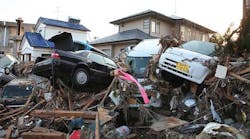WASHINGTON - Large earthquakes around the world have been found to trigger tremors at U.S. sites where wastewater from gas drilling operations is injected into the ground, a U.S. study said Thursday.
For instance, the massive 9.0 magnitude earthquake in Japan in 2011 set off a swarm of earthquakes in the western Texas town of Snyder near the Cogdell oil field, culminating in a 4.5 magnitude quake there about six months later, said the research in the journal Science.
Similarly, small to midsized quakes were observed near active injection wells in Prague, Okla., following an 8.8 magnitude quake in Chile in 2010.
Uncommon seismic activity stirred that region 16 hours after the Chile quake with a 4.1 magnitude tremor, and it continued until a 5.7 magnitude quake in November 2011, said researchers at Columbia University's Lamont-Doherty Earth Observatory.
The 2010 Chile quake also led to heightened seismic activity in Trinidad, Colo., including a 5.3 magnitude quake in August 2011, in an area where methane is extracted from the coal bed and wastewater is reinjected into the earth.
"We weren't really confident until we found the same pattern of little bursts of seismicity following the passage of seismic waves from several of these big earthquakes," lead author Nicholas van der Elst of Columbia University told AFP.
Not Coincidence, Say Researchers
"Any individual case could be a coincidence but once you start observing it systematically, then you can have more confidence that you are really looking at a physical relationship."
The study helps explain a surge in earthquakes in the central United States, which in recent years has seen a more-than-six-fold increase in earthquakes over 20th century levels.
An accompanying study in Science said there were 300 3.0-magnitude or higher earthquakes in the central United States from 2010 to 2012, after an average of 21 such quakes per year from 1967 to 2000.
The change coincides with a growing natural gas boom that is based on using large amounts of fluids to crack open rocks for natural gas, known as hydro-fracturing or fracking.
Then, once gas and oil have been extracted from deep within the earth, companies often inject the wastewater back below the surface.
The U.S. Department of the Interior last year also acknowledged an uptick in seismic activity -- predominantly in Texas, Colorado, Arkansas, Oklahoma and Ohio -- where disposal of wastewater through injection wells has "increased significantly," it said.
One of the earliest known cases of wastewater inducing earthquakes dates back to the Rocky Mountain Arsenal Well near Denver, where large amounts of wastewater were injected from 1962 to 1966, leading to a series of earthquakes below magnitude 5.0, the DOI said.
Scientists have long known it is possible for quakes to stir up regions of the earth far away, even in natural circumstances such as hydrothermal fields where there is already high fluid pressure.
New Research Raises Questions
But the new research raises questions about how to manage the risks of causing quakes associated with oil and gas extraction and disposal of wastewater in underground wells.
"These passing seismic waves are like a stress test," said co-author Heather Savage, a physicist at Lamont-Doherty.
"If the number of small earthquakes increases, it could indicate that faults are becoming critically stressed and might soon host a larger earthquake."
The largest so far has been the 5.7 magnitude quake on Nov. 6, 2011, in Prague, Okla., triggered by the Chilean quake a year earlier.
The U.S. quakes have been felt by many people but have caused minimal damage and no deaths, though researchers point out that elsewhere in the world, similarly strong quakes have resulted in massive damage and loss of life.
Scientists have no way of predicting when a particular field has reached a dangerous point, which van der Elst and colleagues described as a "key problem in developing operational strategies" to lessen the earthquake risk posed by human activities.
In an accompanying article in Science, William Ellsworth of the U.S. Geological Survey framed the problem another way.
"Ignorance of the things that we understand we should know but do not leaves us vulnerable to unintended consequences of our actions," Ellsworth said.
Copyright Agence France-Presse, 2013



